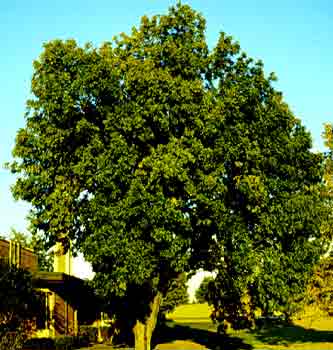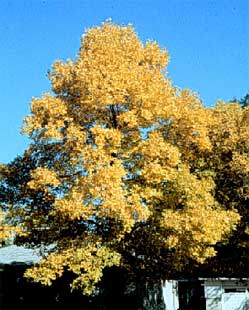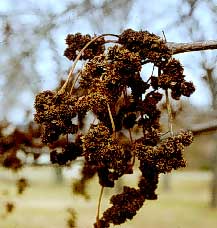 Green Ash - Fraxinus pennsylvanica
Green Ash - Fraxinus pennsylvanica
Olive Family (Oleaceae)
Green ash is not as common as white ash in Kentucky, but it does occur throughout the state. It grows predominantly in moist bottomlands. The Kentucky champion tree is in Estill County and is 150 feet tall.
 Culture: Green ash shows remarkable adaptability and grows very well under most environmental conditions. It requires full sun. Green ash is easy to grow and has been overplanted. Female trees produce a large number of winged seeds each summer. The resulting seedlings unfortunately become invasive and weedy. Planting male cultivars will eliminate seed production. Pruning to correct poor form and weak branch unions is necessary in young green ash trees. The tree should be pruned in fall. Because its wood is brittle, corrective pruning may also be necessary to repair wind and ice damage. Lilac borers and scale insects can cause significant damage. Ash yellows is occasionally a problem in Kentucky. Other potential problems include leaf spots, cankers, ash flower gall and fall webworm. The emerald ash borer (EAB) has become a serious problem in Kentucky. At this time it is difficult to recommend green ash as a landscape tree unless the homeowner has a plan to treat trees with preventative measures. For more information and current conditions on EAB infestation see the UK Entomology Department's online resources at https://entomology.ca.uky.edu/entfact/kentucky-emerald-ash-borer-eab-res....
Culture: Green ash shows remarkable adaptability and grows very well under most environmental conditions. It requires full sun. Green ash is easy to grow and has been overplanted. Female trees produce a large number of winged seeds each summer. The resulting seedlings unfortunately become invasive and weedy. Planting male cultivars will eliminate seed production. Pruning to correct poor form and weak branch unions is necessary in young green ash trees. The tree should be pruned in fall. Because its wood is brittle, corrective pruning may also be necessary to repair wind and ice damage. Lilac borers and scale insects can cause significant damage. Ash yellows is occasionally a problem in Kentucky. Other potential problems include leaf spots, cankers, ash flower gall and fall webworm. The emerald ash borer (EAB) has become a serious problem in Kentucky. At this time it is difficult to recommend green ash as a landscape tree unless the homeowner has a plan to treat trees with preventative measures. For more information and current conditions on EAB infestation see the UK Entomology Department's online resources at https://entomology.ca.uky.edu/entfact/kentucky-emerald-ash-borer-eab-res....
- Native habitat: Nova Scotia to Manitoba, south to Texas and northern Florida.
- Growth habit: Prune this tree when young to avoid structural problems. Pyramidal habit in young trees becomes more oval with age.
- Tree size: Green ash is a fast-growing tree, reaching 50 to 60 feet tall at maturity. Spread is about one-half the height.
- Flower and fruit: Clusters of small male and female flowers bloom on separate plants before leafout; female trees produce tan, single-winged seeds.
- Leaf: Green ash has a large leaf up to 12 inches long with five to nine leaflets. Leaves are medium to dark green and become yellow in fall.
- Hardiness: Winter hardy to USDA Zone 3 (possibly 2b).
There are a number of cultivars of green ash. Popular ones include:
- ‘Marshall's Seedless' or ‘Marshall' - Was the most commonly used green ash cultivar for many years. This seedless cultivar is more vigorous than the species and has attractive dark green, glossy leaves with yellow fall color.
- ‘Patmore' - Is a newer cultivar than ‘Marshall's Seedless.' It has a more uniform shape and is slower-growing than the older cultivar.
- ‘Summit' - Upright form with leaves that are not as glossy and dark as those of ‘Marshall's Seedless.' Has good yellow fall color.
Green ash has airy, dark green foliage that casts shade light enough for grass to grow under it. Fall color can also be guaranteed when using selected cultivars of green ash. In winter, this species' stout, shiny gray twigs bear prominent, hairy, dark brown pointed buds at their tips. The dark buds combined with red-tinged, ash-gray bark that is furrowed into a braided pattern make this tree ornamental in the winter.
The green ash genus name, Fraxinus, is from the Latin name for the Old World ash species. Green ash has a very large native range that extends through central and eastern North America. Although green ash is most abundant in the Mississippi River Valley, a 95-foot national champion is in Michigan.
Green ash is often planted in spoil banks after strip mining has been completed. The compound leaves of green ash emerge late in the spring and are pale yellow-green before becoming medium to dark green. The wood of green ash is used for baseball bats, tennis rackets, tool handles, oars and picture frames.
Male flowers of green ash are susceptible to a gall-forming mite that produces large brown galls that are often mistaken for seeds. These galls persist in the winter and can be unsightly, but they do not harm the tree.



